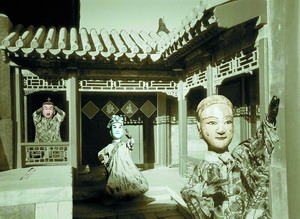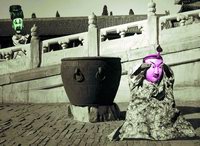by Zhang Zhaohui
 A person's face is a living ID card readout of the content of his or her life. The face directly expresses a person's experience, education, depth, and style, as well as psychological and material conditions. We remember or recognize a person primarily because of the impression made on us by his or her individual look. A person's face is a living ID card readout of the content of his or her life. The face directly expresses a person's experience, education, depth, and style, as well as psychological and material conditions. We remember or recognize a person primarily because of the impression made on us by his or her individual look.
As Chinese cities dramatically grow and transform, human faces take on a wider range and play even greater social roles. Take advertising images. Ordinary consumers most readily accept the face of a beautiful woman or handsome man. Products for beautifying and transforming the face abound, and the faces of stars are used to endorse a wide range of products. In the formation of a commercialized society, the face itself takes on a commercial character. A prettier face is often rewarded with a higher position and salary. A woman's wages often depend on her looks, so it is little wonder that plastic surgeons are so much in demand, even though operations are expensive and dangerous.
Young artists today are attuned to games of visage -- economic, sociological or psychological -- and constantly employ others' faces or their own in their artistic expression of society. The 1999 exhibition "It's Me" featured works by more than 20 young artists who stressed the function of an individual artist's appearance as self-identification in the face of globalization. In an increasingly mechanistic, quantitative, uniform, standardized and manufactured society, and when nation, nationality and spiritual meaning are deconstructed, artists are aware that their own unique faces function as evidence of self-existence.
From a biological perspective, the face is the natural characteristic of a visage. In sociology, the mask serves as a self-protective membrane covering the face. A mature and socially experienced person can clearly distinguish the face from the layering of masks adopted to adjust to a complex and threatening world. Facial decorations signal changes in social fashions and trends, for instance, the South Korean look in vogue among urban youth. When the facial character in the biological sense weakens, the mask in the sociological sense becomes more complex and worldly. As a result, the face of a person becomes increasingly obscure, ultimately becoming only a symbol of personal identity. In contemporary society, colorful and stylish looks suggest variety and romance, making city life more mysterious and alluring. The mask and the face are two important aspects of today's urban personality and they enable the contemporary artist to examine his or her own self-identity. Just like the body, the face, the mask and the look have become vehicles of art.
This exhibition entitled "Mask Vs Face" will show more than 30 works by 12 artists, all focusing on the subject of their own or others' faces and examining the complex relations between masks and faces. The works can be seen as the artists' individual strategies for active involvement in contemporary social life as well as artistic visual information on urban development and social transformation.
 Taking cities as human faces, Wang Jingsong used his camera to investigate and display the faces and characters of cities from a sociological angle. In his work "Replacement of Identity", Cang Xin demonstrates the connections between the identity and faces of laborers from the lowest levels of society. Through computer image manipulation, Li Haibing replaces the faces of various classical Chinese figures with his own face, demonstrating that the heritage of ancient traditions goes on. Feng Zhenjie exhibits the "expressions" of women wearing masks in an exaggerated manner to provide a commentary on contemporary styles. Chen Ke, however, uses mass production techniques to produce replicant pocket faces, investigating the playful ground between painterliness and replication. A woman artist with a trans-cultural background, Tammy Wong's intentional representation of the sensory organs of the face highlights her unusual experience of cultural identity in an age of globalisation, imbuing her "masks" with an added ethnological and cultural significance. Conceptual artist Li Wei locates his face in various urban backgrounds with a mirror that reflects another urban face. Hong Hao's work is a portrait of the elegant living and psychological status of today's middle class and upper middle class, dripping with vogue and luxury. Liu Wei demonstrates the interactive shifts between puppets and faces. In the manner of montage, Shen Ruiyun blends urban street scenes with human faces, conveying her personal experience of the urbanisation of Guangzhou. In Sheng Qi's work, the artist holds an old photograph in his handicapped hand, producing an unforgettable tension between the bright, innocent human look in the picture with the damaged hand. Taking cities as human faces, Wang Jingsong used his camera to investigate and display the faces and characters of cities from a sociological angle. In his work "Replacement of Identity", Cang Xin demonstrates the connections between the identity and faces of laborers from the lowest levels of society. Through computer image manipulation, Li Haibing replaces the faces of various classical Chinese figures with his own face, demonstrating that the heritage of ancient traditions goes on. Feng Zhenjie exhibits the "expressions" of women wearing masks in an exaggerated manner to provide a commentary on contemporary styles. Chen Ke, however, uses mass production techniques to produce replicant pocket faces, investigating the playful ground between painterliness and replication. A woman artist with a trans-cultural background, Tammy Wong's intentional representation of the sensory organs of the face highlights her unusual experience of cultural identity in an age of globalisation, imbuing her "masks" with an added ethnological and cultural significance. Conceptual artist Li Wei locates his face in various urban backgrounds with a mirror that reflects another urban face. Hong Hao's work is a portrait of the elegant living and psychological status of today's middle class and upper middle class, dripping with vogue and luxury. Liu Wei demonstrates the interactive shifts between puppets and faces. In the manner of montage, Shen Ruiyun blends urban street scenes with human faces, conveying her personal experience of the urbanisation of Guangzhou. In Sheng Qi's work, the artist holds an old photograph in his handicapped hand, producing an unforgettable tension between the bright, innocent human look in the picture with the damaged hand.
Mask and face provide a perspective for artists to observe and reflect society, providing a dialectical relationship between urban life and personalcommunication. In the countless editions of this evolving relationship, a splendid and evocative urban scene unfolds.
(Translated by Yang Yingshi and polished by Bruce Doar.)
|
![]() 本网站由北京信息港提供网络支持
本网站由北京信息港提供网络支持
![]() 本网站由北京信息港提供网络支持
本网站由北京信息港提供网络支持